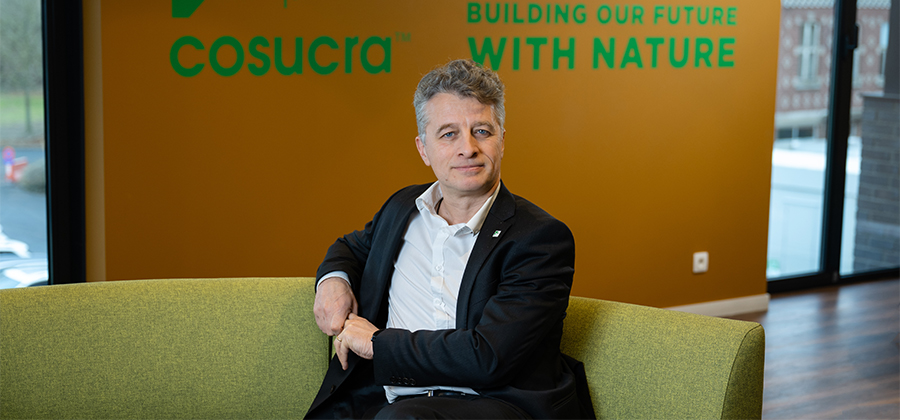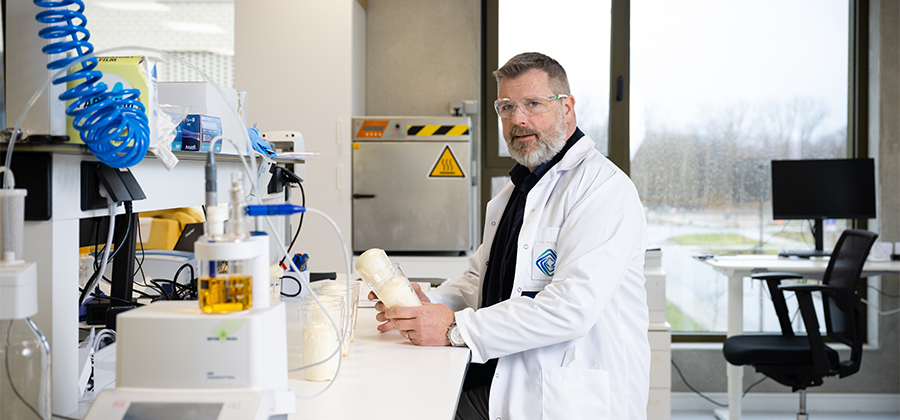A plea to use responsible and regenerative economic models to break the cycle of infinite growth and the misuse of resources deemed "free".

Today, two billion people are members of the global middle class and we are consuming the resources of 1.7 planets. At this rate of consumption, how can we possibly meet the needs of the extra three billion consumers who will join the middle class by 2020? The biosphere will surely not withstand this increase in such a short space of time. According to Matthieu Leroy, until recently IKEA's Sustainability Manager, we have reached the peak of the curve not only for the consumption of oil, but also for sugar, red meat, consumer goods – and furniture. Our carbon emissions are increasing at an exponential rate, but the same applies to toxic emissions jeopardising the water and air and to the earth's deteriorating biosphere. And although the supply of resources is dwindling, only 7% of waste is recycled and injected back into the economy.
Why is this? Because we remain faithful to the linear economic system based on infinite growth, at the expense of the resources of the earth's surface. The consequence of this is that very soon, we will be faced with a considerable risk of shortages of raw materials as well as volatility and increasing prices, for example.
So "extract, produce and discard" should be consigned to history as soon as possible. Scientists say that if we do not drastically alter the factors behind our carbon emissions and use of resources in the next three to five years, climatic phenomena and mass extinctions of species will spiral out of control. To hasten progress towards the new economy, a new EU law is under discussion that would aim to oblige companies to retain ownership of the materials they use to produce their products, selling only the service linked to their use. But our pragmatic neighbours in the Netherlands have pushed ahead: there, 50% of purchases made by state services must be circular by 2030.
Let's switch as soon as we can
Innovation is certainly gaining ground on our old habits: examples include "light as a service" for retailers, whereby you only pay for the light you use and not the actual lights, contracts for the use of tyres on demand, and office photocopiers that are easily disassembled and only available under leasing agreements. Initial experiences of circularity show that the concept produces greater benefits in the medium term than simple sales. But at this stage of designing environmental strategies in the majority of companies, the focus mainly falls on a marginal reduction of negative impacts.
"This won't be enough", declares Matthieu Leroy. "We cannot continue to increase well-being and to grow if we do not firstly consume better, but also consume less." Though Leroy's former employer IKEA is active in recycling, his passion for the circular model led him to go further and establish STRATA.
His company provides furniture for hire rather than sale, catering for the niche market of landlords who offer accommodation to students or expatriates. "When a table has served its purpose or has gone out of fashion, it is typically discarded as a whole. The same applies to an item of child's furniture that in under two years is no longer useful", continues Leroy. He advocates an entirely new approach that involves a fundamental review of the way we create value, and no longer regards customers as consumers of products but as users of services.
Frentlife is another young Belgian firm illustrating the same furniture hire concept. When the furniture is no longer useful it is either collected and replaced or given to charity.
Several years ago, Amsterdam's Schiphol Airport signed a contract with its provider to receive light "as a service": the provider retains ownership of everything up to the bulbs which it is responsible for installing and replacing, so that the airport always has sufficient light. Costs are lower for the airport, and Philips considerably increases its profit margin while also establishing a long-term customer relationship and drastically reducing the effect on the environment. What could be better than that?
The message is circular
The circular economy aspires to be a model that repairs and regenerates, that abolishes the very idea of the lifespan and replaces it with the goal of reusing for the longest possible period, repairing and recycling. It allows action in various domains, some of which are preferred by companies. One example is the use of non-toxic biological materials (such as biomass and wood) that harmlessly re-enter the biosphere, eliminating any type of waste. Technical components could, once optimised, be reintegrated into a new manufacturing process.
It will also be necessary to design and shape our products for the future in order to extend the lifespan of everything we make. Product-service systems, assisted by technology and market places that connect supply and demand, are another phenomenon increasingly breaking the link between the financial growth of companies and the use of resources. The owners of the Uber and Airbnb platforms have no resources of their own since they rely on what their members have to offer. Alas, a philosophy that remains strongly capitalistic means they have not entirely left behind the linear world, and their wider social effects remain significant.
Other forerunners have taken up the idea of turning waste produced by another firm into resources for use. So some of the 9,500 products appearing in the IKEA catalogue are made from cardboard and plastic waste produced by its own stores. For more examples and details of the five circular economy business models, read the article Progress towards the circular economy. In addition to these, Matthieu Leroy's advice is to explore a variety of areas for action.
Gone too: capturing value and keeping it for yourself
This approach is undoubtedly more disruptive and still rarely used. However, companies are beginning to link up to create value jointly, doing so more quickly than they would if working alone. Solar Impulse is among the first incarnations of this quest for common value and its capacity to speed up the transition. Sharing developments in this way promotes faster learning by the engineers of the parties involved. The Solar Impulse Foundation brings together Solvay, the Lausanne Ecole Polytechnique, Google and others, who are creating the solar aeroplane and will then share the benefits – both tangible and intangible. Value can sometimes be purely intangible, for example media exposure given to the project partners. This makes it no less advantageous to the parties involved.
Models which are 100% responsible
For Matthieu Leroy, a genuine transformation requires innovative models, including a complete mapping of the positive and negative effects of the activity in order to take into account all "externalities".
"Externalities – such as the generation of large quantities of waste or the carbon impact of extraction, production, use or premature shortening of product lifespans – are not on the whole considered when a conventional business model is established. They just need to be taken into account when businesses are designed. It's not that difficult to do but it's key", he explains. Since he continues to own his furniture, Leroy has every interest in designing modular pieces that last as long as possible and can be assembled or disassembled quickly and easily.
And this is the only way to reduce costs in a circular system. Operating in this way means the manufacturer optimises their model: revenue is more predictable thanks to regular income throughout the lifespans of their products, which are lengthened considerably for the benefit of everyone. Rental also proves cheaper for users, since the object is reintegrated into the circuit in a way that saves energy, materials and labour and produces positive social and environmental externalities.
As a bonus, users becomes less reliant on commodities and their cost. "For example, by renting a piece of furniture to 10 different customers rather than selling it to just one, you can double your growth more easily while also divorcing it from your resource needs. In this way, you can seriously limit your negative impact. The CEO of Philips says this is very profitable in the medium term and I take his word for it!" Leroy adds.
16.05.2024
Kazidomi: a healthy online supermarket
A subscription to build customer loyalty, reinvent yourself in times of crisis and buy better: Emna Everard saw that as exactly the right way to launch and maintain her Brussels-based start-up.
Born into a family of dietitians, Emna Everard knows what it means to eat healthily. "At the age of 12, I was already deciphering packaging labels. My dream was to open a supermarket one day where you could shop with your eyes closed", she recalls.
And because Everard has entrepreneurship in her bones, that’s exactly what she did. In 2016, just before the end of her university studies, she launched the “healthiest online supermarket on the market”: Kazidomi. Her standards are high, both in terms of composition and taste. Kazidomi selects products carefully, enabling its customers to buy healthy, mainly organic, plant-based products with complete confidence.
The loyalty programme
Six months after its launch, Kazidomi’s growth is accelerating thanks to the launch of its loyalty programme. A 59 euro subscription offering 20–50% discounts on all food, cosmetics or care products available online. Profitability and savings guaranteed.
This was followed by a first fundraising of €50,000 in 2017. Kazidomi is growing, expanding the size of its stock and developing its marketing. Everard hired her first two employees. Sales grew rapidly and literally exploded during the COVID-19 pandemic. "Consumers suddenly had time to think about their health and well-being and were doing most of their shopping online," she adds.
How did you reinvent yourself?
The post-crisis period was a turning point. "Kazidomi had to reinvent itself. We wanted to have financial stability and avoid any dependence on external resources," continues Everard. Together with her teams, she looked at their cost structure, operational efficiency and marketing. After these reflections, the aim was no longer growth at any price, but the company's long-term viability and financial health, thanks to an intelligent reorganisation.
Two acquisitions would subsequently enable Kazidomi to boost its growth, creating significant synergies: "Smart Fooding" in August 2022 and "Bébé au Naturel" a few months later, a business specialising in healthy products for babies and their parents. "With Bébé au Naturel, we doubled the volume of orders sent out," adds Everard. "This has allowed us to get a better rate from our carriers and reduce costs."
A responsive and attentive bank
As the Brussels start-up’s bank, BNP Paribas Fortis granted it three loans for its launch, between 2016 and 2019. This support came naturally, with Kazidomi’s commitments in terms of Environmental, Social and Governance (ESG) objectives perfectly aligned with the bank’s strategy. "We joined the BNP Paribas Fortis Innovation Hub programme and our relationship manager – who knew the start-up environment extremely well – was immediately enthusiastic and very attentive. He believed in our project, followed it closely, advised us to participate in a series of events to meet other players whose background and profile would be of interest for us," explains the Entrepreneur of the Year 2019.
But the support didn't stop there. "In December 2022, it was thanks to BNP Paribas Fortis, among other things, that we were able to acquire “Bébé au Naturel”. Start-ups like Kazidomi need a high level of responsiveness from their bank. When there is a company to buy, or another opportunity, things have to move fast. Analysis of the file, provision of funds: BNP Paribas Fortis has always been responsive and enthusiastic and has supported us in 99% of our requests," says the CEO enthusiastically.
|
Eight years since launching, Kazidomi today has 4,000 products that it delivers across Europe. The Belgian start-up makes 90% of its sales on its website and 10% via external resellers, such as Delhaize. Kazidomi has also launched its own brand “Kazidomi”, which has 200 products on offer. By working directly with producers, we can offer the best possible quality products at the best price. |
Kazidomi is ready to change the world. Discover even more inspiring entrepreneurial stories.
14.05.2024
Less CO2 and healthier food
Cosucra is investing in the decarbonisation of its production processes. Their focus is on using fibre and plant-based protein from chicory and peas for a healthy and less polluting diet.

Belgium’s Hainaut-based Cosucra has been operating since 1852. The company is quite small with 365 employees, but its activities have evolved over time. From the 1980s onwards, sugar beet processing gave way to chicory and yellow peas. Also, sugar was replaced by inulin and pea protein.
"Many families lack the time to put a fresh meal on the table every day. With our products, the industry can offer them easy, quick and nutritious meals," says Eric Bosly, CEO of Cosucra. "Nutritionists stress the importance of fibre and plant proteins for health, and such a diet has a positive impact on our carbon footprint."
New investors
To take their decarbonisation a step further, in 2023, the company launched a seven-year investment plan worth EUR 150 million. “We are keenly aware of the climate crisis, so we wanted to make this transition fast,” says Bosly. “That's why we brought three investors on board who share our values and are willing to commit in the longer term.”
Long-term relationship
Cosucra and BNP Paribas Fortis have a long-standing partnership. "The bank has supported us in expanding to Denmark and the United States. It's of great value to have the same contact person for setting up the financial structure of subsidiaries, opening accounts abroad, etc. We also meet regularly, which means we can count on the expertise of teams specialised in the food industry. Their macro vision complements that of our local account managers who know our business well."
Same market conditions
Cosucra’s efforts will result in a 55% reduction in CO2 emissions within three years. Yet, decarbonisation is just one of Bosly’s bold ambitions. "We are pushing for the same market conditions as animal proteins. Why, for example, is 20 per cent VAT levied on pea-based milk while for cow’s milk, this figure is under 6 per cent? Plant-based products are also more expensive because you can't achieve economies of scale due to the lower quantities required. If you consider all the “negative external effects” of animal products on human health and the environment, our sector deserves support until we reach a certain scale."
Change of mindset
The entrepreneur also laments how the retail sector uses meat as a decoy product, lowering its margins to offer consumers an attractive price. "In times of inflation, that price difference is all the more detrimental to us. This is why a change of mindset is essential. Nutritionists say that a weekly serving of just 200 to 250 grammes of meat is enough to get the nutritional benefits with no negative impact. But at the moment, most Belgians consume 200 grammes of meat per day."
Bosly also cites competition from imported agricultural products as an obstacle.
Cosucra is ready to change the world. Discover even more inspiring entrepreneurial stories.
"The European Green Deal aims to reduce inputs by half, leading to the ban of many herbicides, among other things. Farmers should be supported in this transition. And a company like Cosucra, which buys chicory and peas within a 200-kilometre radius, is not on an equal footing with strong Chinese competition."
13.05.2024
Brepols prepares for the future
Since 1796, Brepols has been producing diaries that allow you to better plan your time. The team is fully committed to people, the planet and prosperity.
"From Turnhout to a branch in Paris, our 110 employees create tools that help our customers manage their time better. And that benefits their work-life balance," says Finance Director Philippe Pissens. "Quality, craftsmanship and creativity are at the heart of our products. Brepols’ diaries, calendars and notebooks are not disposable products - they easily last a year. We also make business leather goods under the Maverick brand and and we have launched a brand-new collection of high-quality notebooks under the brand name "de KEMPEN". In addition, we distribute the famous Moleskine notebooks. Finally, there are our bookbinding activities," he says. Brepols’ main markets are the Benelux and France.
Financially on track
Since starting out in 1796, Brepols has seen many trends and developments come and go. The last few years have been marked by growth. This is thanks to the Financial Director, who came on board in 2000. With turnover of EUR 17.4 million in 2021, EUR 19.6 million in 2022 and EUR 20.8 million last year, the company is clearly on the right financial track. "These figures are not just a result of price increases. We are a strong company with a solvency of 70 per cent, which means that we only finance 30 per cent with external funds," he explains.
More than planting trees
"Since 2009, we have only used Forest Stewardship Council (FSC)-labelled paper. For every tree cut down, a new one replaces it. But there's always room for improvement. In 2022, we launched a project group comprising staff across the company. We call it P3, because we focus on people, the planet and prosperity."
The project group analysed the company’s strengths and weaknesses, with the employers’ organisation Voka acting as a sounding board. “We certainly didn't want to make the mistake of greenwashing,” says Pissens. Specifically, Brepols developed 18 action points, which means it already covers nine of the 17 Sustainable Development Goals. In addition to a charter, there is a code of conduct that suppliers must sign and respect. Other initiatives include focusing on local production, limiting residual waste, reducing energy consumption and developing a HR policy that takes diversity and inclusion into account. “The aim of this project group is to create internal and external support and communicate clearly with all our stakeholders.”
Fluid organisation
"Honesty and transparency towards our employees are top priority," Pissens continues. "We have intensive consultations with them, both formal and informal. We deliberately opt for a fluid organisational model, between the hierarchy and the self-managing teams, and there has been a high level of participation. This is crucial as a quarter of our employees will be retiring in the next three years. In this context, we also purchased cobots, which makes the work less physically demanding for our staff."
Clear communication
Pissens emphasises the importance of clear communication to all stakeholders, including its financial partners, such as BNP Paribas Fortis. "The bank has become key to our business operations. We provide our relationship manager with detailed figures and keep her up to date with our sustainable ambitions. Our contacts at BNP Paribas Fortis not only provide us with information about financial products; they also give us tips, such as measuring our energy consumption and the possibilities for subsidies to install solar panels, for example. We have an effective two-way communication. Our collaboration has grown into a real partnership. In our business, paying attention to Environmental, Social, Governance (ESG) aspects is the benchmark in every consultation," Pissens concludes.
Quote
"The bank has become a key figure in our business operations”
Philippe Pissens, Finance Director Brepols
Brepols is ready to change the world. Discover even more great stories from entrepreneurs.
06.05.2024
Triple Helix disrupts the value chain
Triple Helix calls itself the world’s first vertically integrated processing company, offering the industry a completely reversed value chain. Starting with the chemical industry.

Triple Helix aims to create change in the traditional and capital-intensive chemical industry by investing in alternative commodities and recycling. "In a nutshell, we want to prevent products from being incinerated or landfilled at the end of their life by recovering the material streams and turning waste into new commodities," says CEO Steven Peleman. "And I really do mean any waste stream. Our first project is a factory to break down polyurethane foam and reuse it as a liquid raw material for industry."
Venture studio
Peleman and his three partners know the chemical industry inside out and are aware that it is very difficult to broker change. "Some of these plants have been around for decades. Simply saying that we intend to do things radically differently and disrupt the market? That is not how it works, which is why you need smaller companies that serve as a catalyst for change."
The core of Triple Helix is formed by an independent venture studio that sets up and develops circular projects, creating the right ecosystems around them. "We started with the industry we know best and are gradually expanding our business. We now have a dozen legal entities and are working on a new cluster, focusing on CO2 and sulphuric acid recovery."
Friends, family and fools
As a start-up, Triple Helix is still in the investment phase. “This is a huge challenge,” Peleman says. "These days, the only way to finance a venture like ours is to find investors who can afford to take risks, especially in an industry like ours, with expensive installations, test equipment and laboratories. But the profiles you need are also very expensive. Because you need the experience and knowledge. During the start-up phase, you basically have no choice but to rely on friends, family and other contacts. Our credibility is increasing in leaps and bounds, giving us more clout," says Peleman.
Scalable and cost-effective
The polyurethane recycling plant will be their first lighthouse project. "We want to show that our business model works and that it is scalable and profitable to get traditional equity players to invest."
They expect to finalise the financing in the first quarter, so they can start building the factory at the end of March. "We’re ready. The lab results are good. We have a commitment from market players to supply and purchase material. And we are in discussions with three countries to roll out the plant internationally."
Over the next two years, Peleman wants to make the infrastructure profitable and further expand the other ventures. "It’s not our intention to create one hundred companies. But we do want to set up a few that provide actual solutions to problems and then internationalise them. Between five and ten years, we want to be able to say that the entire set-up has been financed, is running smoothly, and delivering great results so that we can hand it down to the next generation."
Ready to push boundaries together
BNP Paribas Fortis has been following and advising Triple Helix for three years, from when they first presented the idea to the concrete development of the financing options. “We went through a learning process with the bank,” Peleman says. “You need to build a relationship and get to know each other, so both parties can assess the risk.”
Today, BNP Paribas Fortis is one of two banks in a consortium that will help finance a large part of the factory. "I see that the bank has the in-house knowledge to understand what we are doing. But understanding what we do is more important than knowledge. And that is something the bank definitely provides."
Triple Helix is ready to change the world. Discover more inspirational stories from entrepreneurs.
Quote
"We went through a learning process with the bank. You need to build a relationship and get to know each other so both parties can assess the risk," says Steven Peleman, CEO of Triple Helix.
